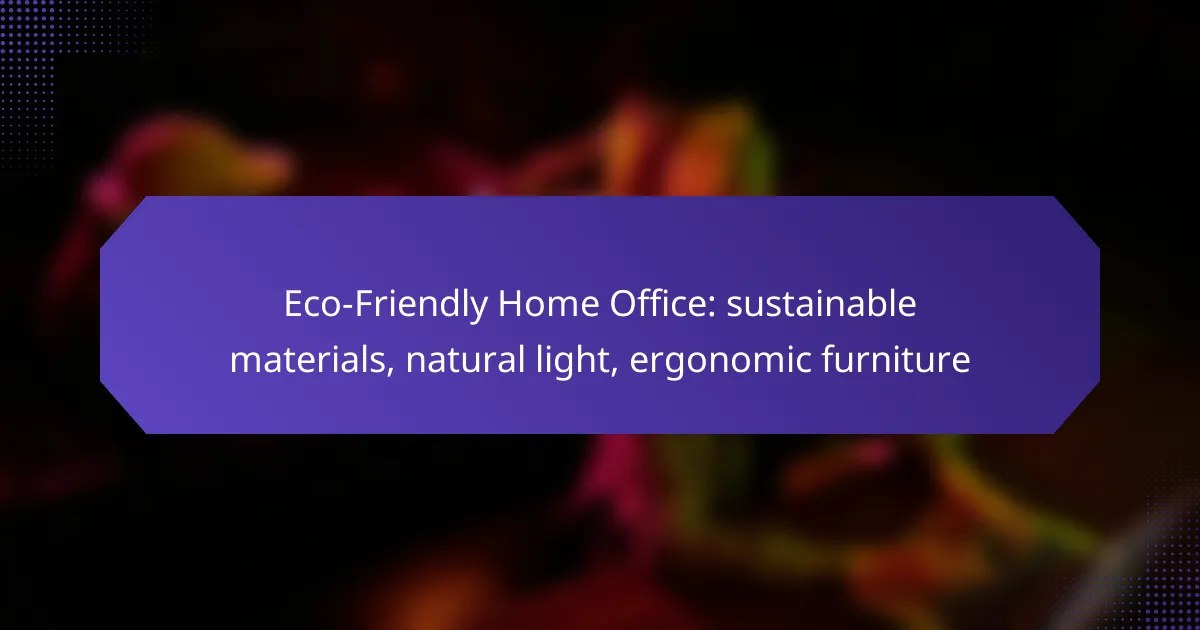Designing an eco-friendly home office is an excellent way to combine sustainability with functionality. By incorporating sustainable materials, maximizing natural light, and choosing ergonomic furniture, you can create a workspace that not only reduces your environmental footprint but also boosts your comfort and productivity.

How to create an eco-friendly home office?
Creating an eco-friendly home office involves using sustainable materials, maximizing natural light, and selecting ergonomic furniture. These elements not only promote environmental responsibility but also enhance comfort and productivity.
Use sustainable materials
Opt for furniture and decor made from sustainable materials like bamboo, reclaimed wood, or recycled metal. These materials reduce environmental impact and often come with a unique aesthetic that adds character to your workspace.
When choosing office supplies, look for items made from recycled paper or biodegradable plastics. This small change can significantly lower your carbon footprint over time.
Incorporate natural light
Maximizing natural light in your home office can improve mood and productivity. Position your desk near windows to take advantage of daylight, which can reduce the need for artificial lighting.
Consider using light-colored curtains or blinds that allow light to filter through while providing privacy. This approach helps maintain a bright atmosphere without compromising comfort.
Choose ergonomic furniture
Investing in ergonomic furniture is crucial for maintaining comfort during long working hours. Look for chairs that support your lower back and desks that allow for adjustable heights.
Ergonomic keyboards and mice can also reduce strain on your wrists and hands. Aim for a setup that promotes good posture and minimizes discomfort.
Implement energy-efficient appliances
Using energy-efficient appliances can significantly lower your energy consumption. Look for products with the ENERGY STAR label, which indicates they meet energy efficiency guidelines set by the U.S. Environmental Protection Agency.
Consider using LED lighting, which consumes less energy and lasts longer than traditional bulbs. This simple switch can lead to noticeable savings on your electricity bill.
Utilize indoor plants
Incorporating indoor plants into your home office can improve air quality and create a calming atmosphere. Plants like snake plants, pothos, and peace lilies are low-maintenance options that thrive indoors.
Additionally, having greenery around can enhance creativity and reduce stress levels, making your workspace more enjoyable. Aim for a few plants to create a balanced environment without overcrowding your desk.

What sustainable materials are best for a home office?
Using sustainable materials in a home office can significantly reduce environmental impact while enhancing aesthetics and comfort. Key materials include bamboo, recycled metal, low-VOC paints, and natural fiber carpets, each offering unique benefits for eco-conscious setups.
Bamboo for desks
Bamboo is a rapidly renewable resource, making it an excellent choice for desks. Its strength and durability rival traditional hardwoods, while its lightweight nature allows for easy mobility. When selecting bamboo furniture, look for products certified by organizations like the Forest Stewardship Council (FSC) to ensure sustainable sourcing.
Consider finishes that enhance the natural beauty of bamboo without harmful chemicals. A simple oil finish can protect the surface while maintaining its eco-friendly profile.
Recycled metal for shelving
Recycled metal is a sturdy and sustainable option for shelving in a home office. It often comes from post-consumer products, reducing waste and energy consumption associated with new metal production. Metal shelves can support heavier items and are resistant to wear and tear.
When choosing recycled metal, verify the percentage of recycled content and look for finishes that are free from harmful coatings. This ensures that your shelving remains safe and environmentally friendly.
Low-VOC paints
Low-VOC (volatile organic compounds) paints are essential for maintaining indoor air quality in a home office. These paints emit fewer harmful chemicals, making them safer for both the environment and your health. They are available in a wide range of colors and finishes, allowing for creative expression without compromising sustainability.
When selecting low-VOC paints, check for certifications like Green Seal or the EPA’s Safer Choice label to ensure compliance with environmental standards.
Natural fiber carpets
Natural fiber carpets, such as those made from wool, jute, or sisal, provide a sustainable flooring option for home offices. These materials are biodegradable and often produced with minimal chemical processing. They add warmth and texture to the space while being more environmentally friendly than synthetic alternatives.
When purchasing natural fiber carpets, consider their durability and maintenance requirements. Some fibers may require special cleaning methods, so be sure to check care instructions to prolong their lifespan.

How to maximize natural light in a home office?
Maximizing natural light in a home office enhances productivity and well-being. By strategically positioning your workspace and using reflective materials, you can create a bright and inviting environment.
Position desk near windows
Placing your desk close to windows allows you to take full advantage of natural light. Aim for a position where sunlight directly illuminates your workspace, ideally within a few feet of the window.
Consider the direction of the windows; south-facing windows typically provide the most consistent light throughout the day. Avoid placing your desk in a way that creates glare on screens, which can be distracting.
Use light-colored curtains
Light-colored curtains can help diffuse sunlight while still allowing ample light to enter the room. Opt for sheer fabrics that soften harsh sunlight without blocking it completely.
Choosing colors like white, beige, or pastels can brighten the space and create a more open feel. Avoid heavy drapes that absorb light, as they can make the room feel darker and more confined.
Incorporate mirrors for reflection
Mirrors can significantly enhance the amount of natural light in your home office by reflecting light around the room. Position mirrors opposite windows to maximize their effect.
Consider using decorative mirrors that complement your office decor while serving a functional purpose. A well-placed mirror can create the illusion of a larger space and improve overall brightness.

What ergonomic furniture options are available?
Ergonomic furniture options enhance comfort and productivity in a home office by promoting better posture and reducing strain. Key choices include adjustable standing desks, ergonomic office chairs, and supportive footrests, each designed to cater to different aspects of work-related comfort.
Adjustable standing desks
Adjustable standing desks allow users to switch between sitting and standing positions, promoting movement and reducing the risks associated with prolonged sitting. Look for models that can be easily adjusted with a crank or electric motor, and ensure they have a height range suitable for your stature.
When choosing a standing desk, consider the surface area for your equipment and the stability when raised. Many options come with built-in cable management features, which help maintain a tidy workspace.
Ergonomic office chairs
Ergonomic office chairs are designed to support the natural curve of the spine and promote good posture. Features to look for include adjustable seat height, lumbar support, and armrests that can be modified to fit your body shape.
Investing in a quality ergonomic chair can significantly reduce discomfort during long working hours. Aim for a chair that allows for adjustments in multiple areas, ensuring it fits your unique body dimensions and work habits.
Supportive footrests
Supportive footrests help maintain proper posture by allowing your feet to rest comfortably while sitting. They can alleviate pressure on the lower back and improve circulation, especially during extended periods of sitting.
When selecting a footrest, consider options that are adjustable in height and angle, as this can enhance comfort based on your chair and desk setup. Look for non-slip surfaces to ensure stability during use.

What are the benefits of an eco-friendly home office?
An eco-friendly home office offers numerous advantages, including improved health through better air quality and increased productivity. By incorporating sustainable materials, maximizing natural light, and choosing ergonomic furniture, you create a workspace that supports both well-being and efficiency.
Improved air quality
Creating an eco-friendly home office significantly enhances air quality, which is crucial for maintaining focus and health. Using non-toxic paints, natural materials, and indoor plants can help filter pollutants and increase oxygen levels.
Consider incorporating plants like snake plants or peace lilies, which are known for their air-purifying properties. Regularly ventilating your workspace by opening windows or using air purifiers can further improve indoor air quality.
Enhanced productivity
An eco-friendly home office can lead to greater productivity by fostering a comfortable and inspiring environment. Natural light, for instance, has been shown to boost mood and energy levels, making it easier to concentrate on tasks.
To maximize natural light, position your desk near windows and use light-colored furnishings to reflect sunlight. Additionally, ergonomic furniture can reduce discomfort and fatigue, allowing you to work more efficiently throughout the day.










